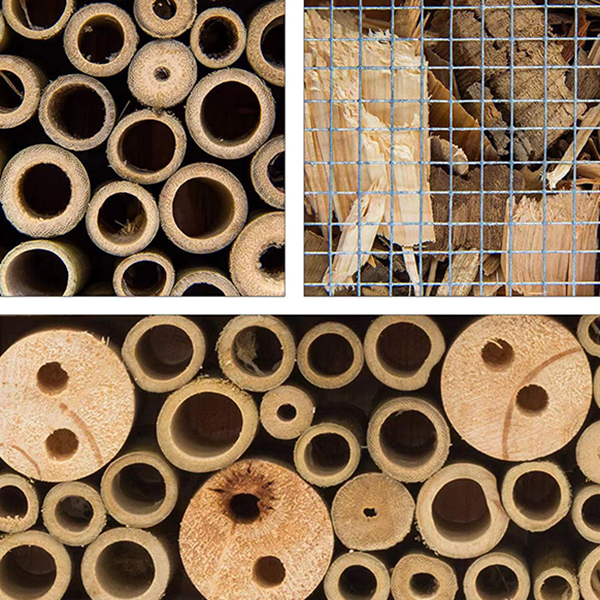Transform your garden into a thriving ecosystem with a simple yet revolutionary tool: the multi-chamber insect habitat. This wooden sanctuary, crafted from untreated fir wood (31×10×48 cm), isn’t just a decorative addition—it’s a lifeline for bees, butterflies, ladybugs, and lacewings. By providing secure nesting and hibernation spaces, this habitat turns your outdoor space into a biodiversity hotspot while reducing pests and boosting pollination naturally.
1. Science-Backed Design: Why Multiple Chambers Matter
Beneficial insects have divergent needs:
- Solitary bees (like mason or leafcutter bees) require 6–10 mm bamboo tubes to nest and lay eggs.
- Ladybugs and lacewings seek wood shavings or pinecones for overwintering, emerging in spring to devour aphids and mites.
- Butterflies use bark-covered compartments for temporary shelter and hibernation.
Unlike single-chamber designs, this multi-room setup prevents cross-species conflicts and caters to specialized behaviors. For example, Shanghai’s Chenshan Botanical Garden uses separate chambers filled with bamboo, pinecones, and bark to attract diverse species—proving targeted design works.

2. The Biodiversity Engine: From Pollination to Pest Control
A well-populated insect habitat acts as your garden’s natural workforce:
- Pollination Powerhouse: Solitary bees pollinate 120× more efficiently than honeybees. Bamboo tubes in the habitat support their reproduction, directly increasing fruit and vegetable yields.
- Pest Control Squad: One ladybug eats 150 aphids daily; lacewings eliminate red spiders and mites. By providing winter shelter, you ensure these predators return each spring.
- Soil Health Boosters: Ground beetles (attracted by wood shavings) aerate soil and decompose organic matter, enriching your garden’s foundation.
Guangzhou’s Liuhua Lake Park reported fewer plant diseases after installing similar habitats—proof that insects restore ecological balance.
3. Strategic Installation: Where and How to Maximize Impact
Placement determines occupancy rates:
- Sun Exposure: Mount facing southeast (3–5 ft high) for morning warmth and afternoon shade. This mimics insects’ natural nesting preferences.
- Shelter: Position near flowering plants (e.g., lavender, coneflowers) or water sources (shallow dishes with stones prevent drowning).
- Avoid Disturbances: Keep away from high-traffic areas and pesticide sprays. Even small “insect sanctuaries” in quiet corners significantly boost populations.
Pro Tip: Add a dripping water source nearby—dragonflies and butterflies flock to moisture-rich zones.

4. Maintenance That Matters: Seasonal Care Tips
Sustainable habitats need minimal but critical upkeep:
- Spring: Clear debris from chambers and replace 30% of bamboo tubes to prevent parasitic mites. Add fresh pinecones to attract new ladybugs.
- Summer: Ensure wood remains dry. A slight roof overhang (like the habitat’s 2–3 cm design) prevents rain damage.
- Autumn/Winter: Stuff chambers with fallen leaves or straw for insulation. Never move the habitat—overwintering insects rely on stable conditions.
5. Beyond the Garden: Educational and Ecological Ripple Effects
This insect habitat isn’t just functional—it’s a conversation starter about urban ecology. In Shanghai’s community gardens, mini-habitats teach children about food webs, while parks use them to rebuild vanishing insect populations (like fireflies and native bees). By installing one, you join cities like Guangzhou and London in a global movement to turn concrete jungles into wildlife corridors—one bamboo tube at a time.
Ready to become a biodiversity steward? Hang your multi-chamber habitat in a sunny spot, observe its inhabitants, and watch your garden transform into a self-sustaining ecosystem. Share your insect sightings using #InsectHotelHeroes—we’d love to celebrate your rewilding journey!
Explore our sustainably built insect habitat → Shop Now

